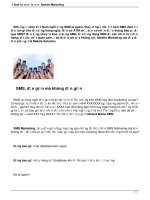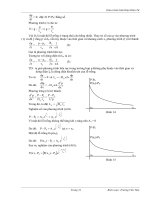Chapter 7 coupling VẼ CƠ KHÍ
Bạn đang xem bản rút gọn của tài liệu. Xem và tải ngay bản đầy đủ của tài liệu tại đây (2.88 MB, 52 trang )
MECHANICAL COUPLING ACCOUPLEMENT
Shaft Couplings
Couplings are mechanical elements that ‘couples’ two drive elements which
enables motion to be transferred from one element to another. The drive
elements are normally shafts. We tend to see lot of applications of the
couplings mainly in the automobiles, for example the drive shaft which
connects the engine and the rear axle in a bus or any automobile is
connected by means of a universal joint.
In order to transmit torque between two shafts that either tend to lie in the
same line or slightly misaligned, a coupling is used. Based on the area of
applications there are various types of coupling available. But they are
generally categorised in the following varieties
1. Rigid Couplings
2. Flexible or Compensating Couplings
RIGID COUPLINGS
Rigid Couplings are mainly used in areas
where the two shafts are coaxial to each
other. There are many types of couplings
that fall under the rigid couplings
category. They are
· Rigid Sleeve or Muff Couplings- This
is the basic type of coupling. This consists
of a pipe whose bore is finished to the
required tolerance based on the shaft
size. Based on the usage of the coupling
a keyway in made in the bore in order to
transmit the torque by means of the key.
Two threaded holes are provided in order
to lock the coupling in position. The photo
shows a type of the rigid sleeve or muff
coupling.
FLEXIBLE OR COMPENSATING
COUPLINGS
Flexible couplings are normally used in
areas where the coaxiallity between the
connecting shafts is not always assured
and in areas where there is a possibility of
occurrence of shocks in the transmission is
applicable. They are also called as Elastic
Couplings. By construction these couplings
tend to have a elastic member in between
the two connecting entities. The different
types of flexible couplings are
1. Flanged Pin Bush Couplings
2. Bibbly Coupling
3. Gear Tooth Coupling
4. Tyre couplings
5. Elastomeric Couplings – This consists of
jaw type and S-flex couplings.
6. Oldhams Coupling
7. Universal Coupling or Hooke’s Coupling
8. Bellows Coupling
Each of the above couplings are quite
unique in their construction and we can
deal in detail on their constructional and
1. Flanged Pin Bush Couplings
2. Bibbly Coupling
Bibby are the world originator of the
resilient grid type shaft coupling, which is
universally accepted by engineers to be
one of the most effective shock absorbing
and
de-tuning couplings in existence.
In addition to these vital attrihutes, Bibhy
Transmissions' resilient grid couplings can
accommodate angulan parallel and axial
misalignment between driving and driven
shafts, whilst absorbing considerable
torque overloads and smoothing cyclic
variations.
The result is smoother running machineryr,
minimising downtime and protecting your
investment in plant and production.
Tyre couplings
Bellows Coupling
AN AUDI GEARBOX
CLUTCH
AMBRAYAGE
Friction Plate Clutch
Mechanical Clutch
Clutch Drive
Clutch Transmission
Torque Clutch
Magnetic Clutch
LY HỢP
TUỘT KẾT
A dog clutch : Ly hợp chốt
is a mechanism used to connect and disconnect
two rotating shafts or machine parts. It functions by mating a
set of regularly spaced teeth or protrusions on one half of the
clutch mechanism to a set of identical recesses on the other,
rather than using the friction principle used in other clutches.
This has the benefit of allowing both shafts to turn at the same
speed without slipping and with minimal clutch wear. They can
not, however, be used to control torque as is the case with a
friction clutch. Dog clutches are commonly used in manual or
stick shift automobile gearboxes, marine propeller drives, and
on the drives of heavy machinery.
This type of clutch is typically made up of two round plates,
one fixed to the drive shaft and one to the shaft being driven.
One of the plates has a series of evenly spaced protrusions
machined into its face, similar to the battlements on top of a
castle wall. The other has an identically spaced series of
like-sized recesses cut into its face. When the two plates are
brought together, the protrusions mate or fit into the recesses,
thereby effectively joining the shafts and transferring rotational
motion from one to the other. This ensures a strong mechanical
coupling between the two components with no slip characteristics.
Due to the lack of slippage, the clutch mechanism is not subjected
to the amount of wear and tear that is encountered with friction
clutches. It does not, however, allow for the gradual initiation of the
drive process and resultant torque control that a friction clutch
does as the drive engagement is immediate. This type of clutch
arrangement allows for a strong, reliable transfer of rotational
motion between components using a minimum of moving parts
and constant maintenance of equal shaft speeds. One of the most
common uses of a dog clutch is the drive engagement of individual
gears in a manual automobile gearbox.
When different gears are selected in this application, a
synchromesh system allows the drive and selected gears to mesh
smoothly. Most marine stern drive and outboard engines use such
clutches in their gear trains as do bicycle hub gear assemblies.
Large arrangements are also commonly used in the main and
auxiliary drive trains of heavy machinery, such as excavators
where it's essential for there to be no clutch slippage.
Another well known use of this type of clutch is the cord pull-start
system
on gasoline engines.









